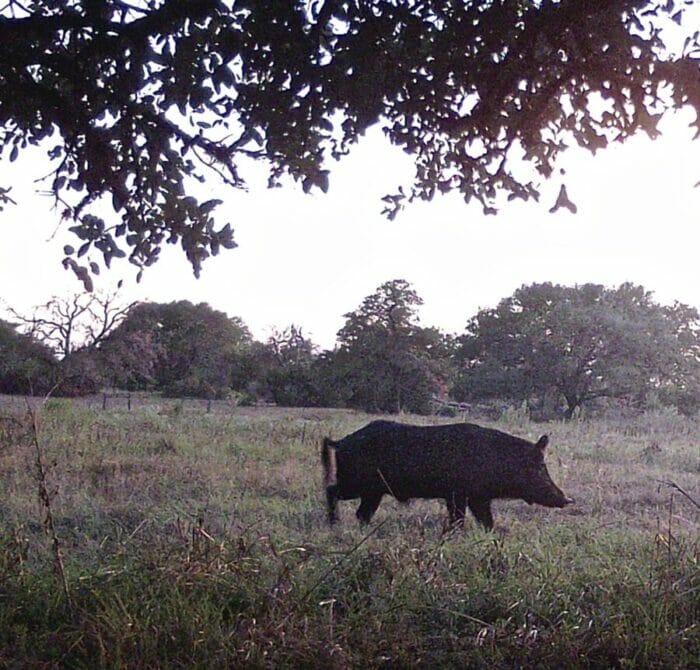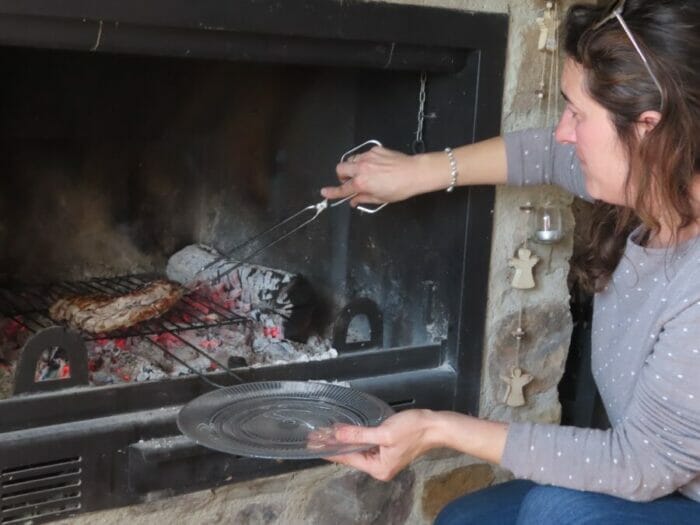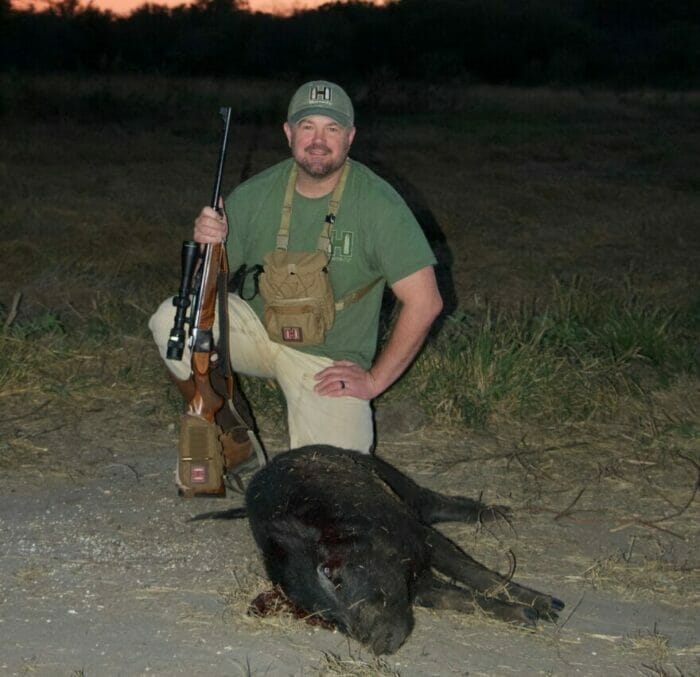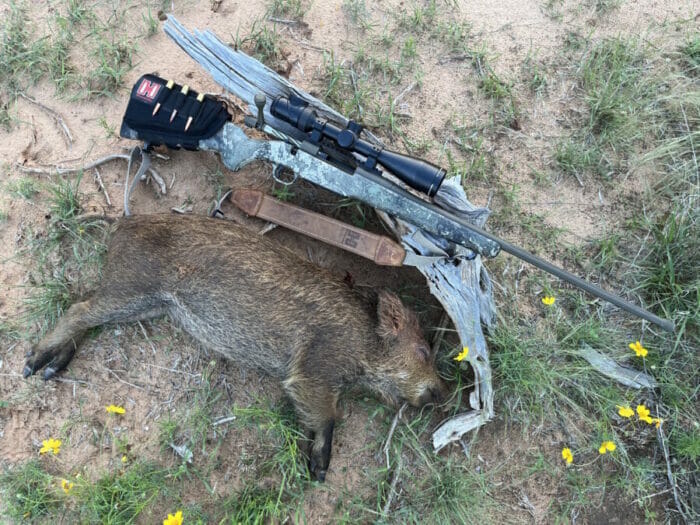From A Sow’s Ear
“Making a silk purse out of a sow’s ear.”
I have heard that old saw for many years when someone referred to making something out of basically nothing! But there is certainly merit in what it means!
Recently while visiting with Greg Simons, fellow wildlife biologist and wildlife entrepreneur with Wildlife Systems, we talked about a myriad of outdoor topics, from his soon-to-be-released new book on the hunting industry to the merits and demerits of wild hogs. We discussed how wild hogs might be somewhat wrongly maligned, particularly how they could be an excellent food source for humans during tough times, even though many are shot and not utilized today. “I’d guess maybe ten percent of the wild hogs killed here in Texas are saved and used for human food. A shame when you think about the amount of protein being wasted each year. Although I guess if allowed to return to the soil, there may be some benefits.” Said Greg. He continued, “A few years ago, I was at a wildlife meeting near Albany (Texas). We were discussing wild hogs. Johnnie Hudman stood up and said, “I think it’s time we started utilizing wild hogs and making a silk purse out of sows’ ears…no pun intended!”. It was his way, so saying it was time, we took what many considered a negative and turned it into a positive, doing so in a fun yet appropriate way! At a minimum, think of what we could do providing protein from wild pork to those people who are hungry and in need of food.”
“Typical of Hudman! But also an excellent point!” I added.
The Rise of the Swine
Johnnie Hudman and I have been friends and occasional hunting partners since the middle 1970s when I was a wildlife biologist stationed in Abilene, a few miles south of Albany, where Johnnie lived. Initially mere acquaintances, we soon became dear friends who shared a love of hunting, history, and the outdoors.
Back then, people were becoming aware of wild hogs even though they had been in Texas since the days of the early Spanish explorers. Spanish “Conquistadores” brought “swine” with them wherever they explored and hoped to colonize. Hogs traveled well on ships. They survived on eating almost everything and did well in confined areas while on sailing ships. They were highly adaptable to a wide variety of terrain and weather conditions. And, they have a high reproductive rate, producing two and a half litters per year.”
Some Spaniards’ hogs escaped the swineherders and survived in their new home. Some, too, were undoubtedly released in hopes they would survive, reproduce and provide food for future expeditions into the “New World.” Later with the arrival of European settlers, they too brought hogs. Like the Spanish explorers, some escaped, and others were “stocked” to reproduce, so the following immigrants had pork and lard as potential food sources.
Bringing animals into new areas that might later be colonized was not unique. In another era, Roman armies brought fallow deer wherever they traveled. Some were herded, and others were released to form broodstock to create a future food source for their troops and settlers. Much of Europe these days has fallow deer because of those early introductions by the Romans.
As a youngster, I remember my dad telling stories of how my granddad and other area farmers and ranchers, just up from the edge of Texas Gulf Coast Prairie, would, during late summer, release large numbers of hogs into the area’s woods to fatten on the region’s plentiful acorns and pecans. Late winter, the fattened hogs were rounded up. Some were slaughtered turned into sausage, bacon, ham, and, very importantly, lard. Others were sold.
I remember, as a youngster, my family, my grandparents, uncles, aunts, and neighbors fattened hogs to be butchered in November or December after temperatures cooled. My paternal granddad bought older boars, castrated them, and then put them on feed for three or four years. Those barrows grew huge bodies, some weighing more than 800 pounds on good scales. Those monstrous hogs provided huge slabs of bacon and hams, which were salt-cured and smoked to preserve them. They also provided many “rings” of sausage. Mostly these were smoked and dried. And, we rendered many gallons of lard from their “fat.” Hog butchering often involved numerous hogs and several families becoming involved.
Many food “items” were made from the hogs we butchered. But I do not think we ever turned a sow’s ear into a silk purse. But then silk purses inedible, a sow’s ears were!
My grandparents owned real “ice boxes,” which depended upon ice to keep things cool. Ice was not always available. So they found alternate ways to preserve meat by submerging it in lard. Lard was created by cutting the hog’s fat into small strips, squares and boiling those in huge cast iron tubs. This boiled the fat out, turning it from a solid to a liquid while it was hot and a “mushy” liquid when cooled. This left “cracklings,” which were left after the oil had been rendered out of it. “Cracklings” were used in cooking and some baking, particularly mixed in the batter when baking cornbread.”
“My grandmother preserved meat by frying it, then putting it into a large earthen crock. She poured in lard, added another layer of fried meat, then poured in a layer of lard, more fried meat, and more lard until the crock was filled. This preserved the meat for a very long time!
To prepare meals, she took the already fried meat out of the lard, heated it in her oven or on top of the stove, then served it. The lard was also used in baking and frying other dishes. As I recall, the “larded meat” was quite delicious. Food fried and dishes prepared with lard were standard in our part of Texas during the days of my youth.
Because most people of that era did hard physical labor, very few ever had health issues related to eating large amounts of salt or lard. Even so, lard was considered “evil for a long time.” Interestingly these days, after years of lard being given a bad rap, nutritionists are now saying rendered hog lard is better for us than many other oils used these days in preparing food. Lard surely makes foods prepared with it or fried in it taste better!
A Resource Wasted?
At the possibility and risk of aggravating and possibly alienating some people, I think it might be time we start looking at wild hogs as a serious food source. In a time when crops grown for food are at risk because of possible climate change and not-so-reliable precipitation, maybe we should look a little closer at wild hogs. They are found in considerable numbers throughout the southeastern to southwestern US, with the capability of greatly increasing and expanding their range. Feral hogs can live in forests, coastal plains, hills, mountains, desert habitats, and even in the suburbs.
Gilts, yet-to-be-bred females, mature at six months. Upon reaching puberty, sows can produce 2 ½ liter of piglets in the course of a year. This means by the time a mature sow is pregnant with her third litter, those females from the first litter are also pregnant. Litter sizes vary based on nutrition and predators, usually from 2 to as many as 13 or more pigs. If there are few predators, such as coyotes and bobcats, most of the pigs born are later weaned and soon start reproducing.
When it comes to harvesting hogs, a wide variety of firearms or weapons can ce used. I prefer hunting hogs with my Mossberg Predator rifles, topped with Trijicon Huron or AccuPoint scopes. I also like hunting them with my Taurus Raging Hunter handguns, topped with Trijicon’s SRO red dot sights. I use appropriate Hornady ammo in both my rifles and handguns.
I personally do not hunt hogs with semi-auto rifles or hunt at night using thermals, nor with archery or crossbows, although in years past, I hunted with archery equipment. I have no problem with someone using semi-autos topped with thermals, bows, arrows, or crossbows. These are not “my thing”! If someone wants to shoot hogs at night or from a helicopter, that is fine, but the animals taken should be collected and processed for human use rather than left to rot.
Wild hog pork is delicious! Any domestic pork recipe will work equally well with wild pork. But remember, it is important the interior temperature of the meat reaches and exceeds 180 degrees Fahrenheit.
Luke Clayton is my go-to person when it comes to wild hogs. He is a great friend with whom I do a weekly radio show, two weekly podcasts (“Catfish Radio,” which can be listened to at CarbonTV, where we also do a weekly digital TV show with Jeff Rice, “A Sportsman’s Life.” Too CarbonTV is where my weekly podcast “DSC’s Campfires with Larry Weishuhn” can be found, among other places such as Spotify, Stitcher, ApplePodcasts, iHeartPodcasts, and others. Luke and I also do another weekly podcast, “Camp Talk with Luke and Larry,” featured on Sporting Classics Daily and numerous other places. I mention these because Luke and I often address wild hog hunting and cooking them. My old friend has long been a wild hog aficionado and a great supporter of them.”
“Luke is one of the best wild hog cooks I have ever met. A few years ago, he wrote a book about hunting and cooking wild hogs, “Kill to Grill, The Ultimate Guide to Hog Hunting.” It can be purchased by going to Amazon.
Hopefully, wildlife officials and those truly concerned about climate change and the effect it might have on our future food supplies will take a serious look at wild hogs as a human food source. That certainly would be even better than making a silk purse out of a sow’s ear!




